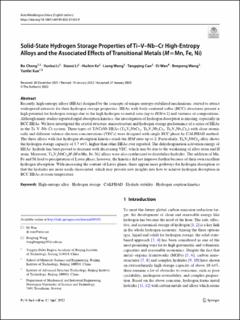| dc.contributor.author | Cheng, Bo | |
| dc.contributor.author | Li, Yunkai | |
| dc.contributor.author | Li, Xiaoxi | |
| dc.contributor.author | Ke, Huibin | |
| dc.contributor.author | Wang, Liang | |
| dc.contributor.author | Cao, Tangqing | |
| dc.contributor.author | Wan, Di | |
| dc.contributor.author | Wang, Benpeng | |
| dc.contributor.author | Xue, Yunfei | |
| dc.date.accessioned | 2022-09-30T11:02:36Z | |
| dc.date.available | 2022-09-30T11:02:36Z | |
| dc.date.created | 2022-04-24T13:18:51Z | |
| dc.date.issued | 2022 | |
| dc.identifier.citation | Acta Metallurgica Sinica (English Letters). 2022, . | en_US |
| dc.identifier.issn | 1006-7191 | |
| dc.identifier.uri | https://hdl.handle.net/11250/3022848 | |
| dc.description.abstract | Recently, high-entropy alloys (HEAs) designed by the concepts of unique entropy-stabilized mechanisms, started to attract widespread interests for their hydrogen storage properties. HEAs with body-centered cubic (BCC) structures present a high potential for hydrogen storage due to the high hydrogen-to-metal ratio (up to H/M = 2) and vastness of compositions. Although many studies reported rapid absorption kinetics, the investigation of hydrogen desorption is missing, especially in BCC HEAs. We have investigated the crystal structure, microstructure and hydrogen storage performance of a series of HEAs in the Ti–V–Nb–Cr system. Three types of TiVCrNb HEAs (Ti4V3NbCr2, Ti3V3Nb2Cr2, Ti2V3Nb3Cr2) with close atomic radii and different valence electron concentrations (VECs) were designed with single BCC phase by CALPHAD method. The three alloys with fast hydrogen absorption kinetics reach the H/M ratio up to 2. Particularly, Ti4V3NbCr2 alloy shows the hydrogen storage capacity of 3.7 wt%, higher than other HEAs ever reported. The dehydrogenation activation energy of HEAs’ hydride has been proved to decrease with decreasing VEC, which may be due to the weakening of alloy atom and H atom. Moreover, Ti4V3NbCr2M (M = Mn, Fe, Ni) alloys were also synthesized to destabilize hydrides. The addition of Mn, Fe and Ni lead to precipitation of Laves phase, however, the kinetics did not improve further because of their own excellent hydrogen absorption. With increasing the content of Laves phase, there appear more pathways for hydrogen desorption so that the hydrides are more easily dissociated, which may provide new insights into how to achieve hydrogen desorption in BCC HEAs at room temperature. | en_US |
| dc.language.iso | eng | en_US |
| dc.publisher | Springer | en_US |
| dc.rights | Navngivelse 4.0 Internasjonal | * |
| dc.rights.uri | http://creativecommons.org/licenses/by/4.0/deed.no | * |
| dc.title | Solid-State Hydrogen Storage Properties of Ti–V–Nb–Cr High-Entropy Alloys and the Associated Effects of Transitional Metals (M = Mn, Fe, Ni) | en_US |
| dc.title.alternative | Solid-State Hydrogen Storage Properties of Ti–V–Nb–Cr High-Entropy Alloys and the Associated Effects of Transitional Metals (M = Mn, Fe, Ni) | en_US |
| dc.type | Journal article | en_US |
| dc.description.version | publishedVersion | en_US |
| dc.source.pagenumber | 0 | en_US |
| dc.source.journal | Acta Metallurgica Sinica (English Letters) | en_US |
| dc.identifier.doi | 10.1007/s40195-022-01403-9 | |
| dc.identifier.cristin | 2018654 | |
| cristin.ispublished | true | |
| cristin.fulltext | original | |
| cristin.qualitycode | 0 | |

